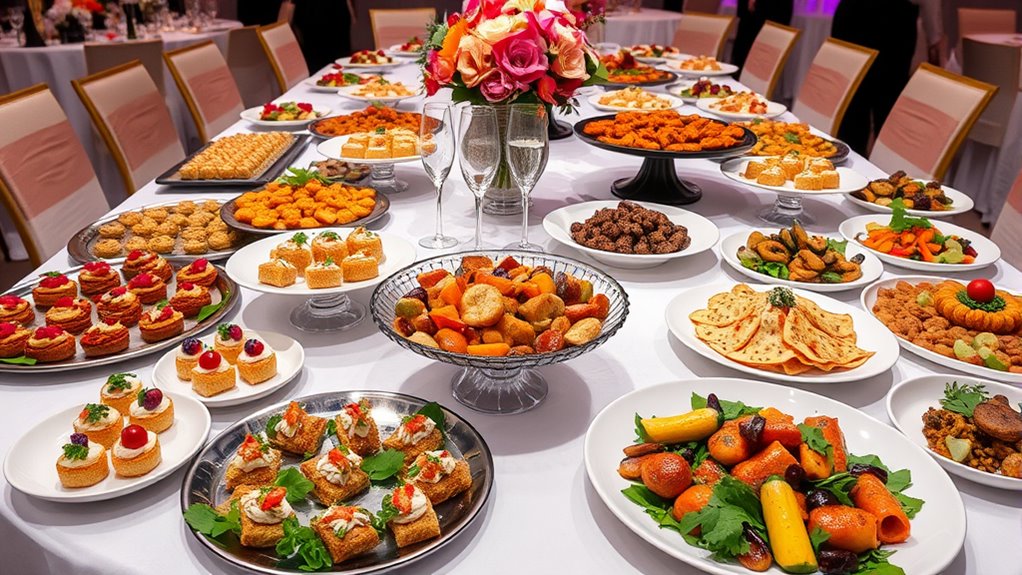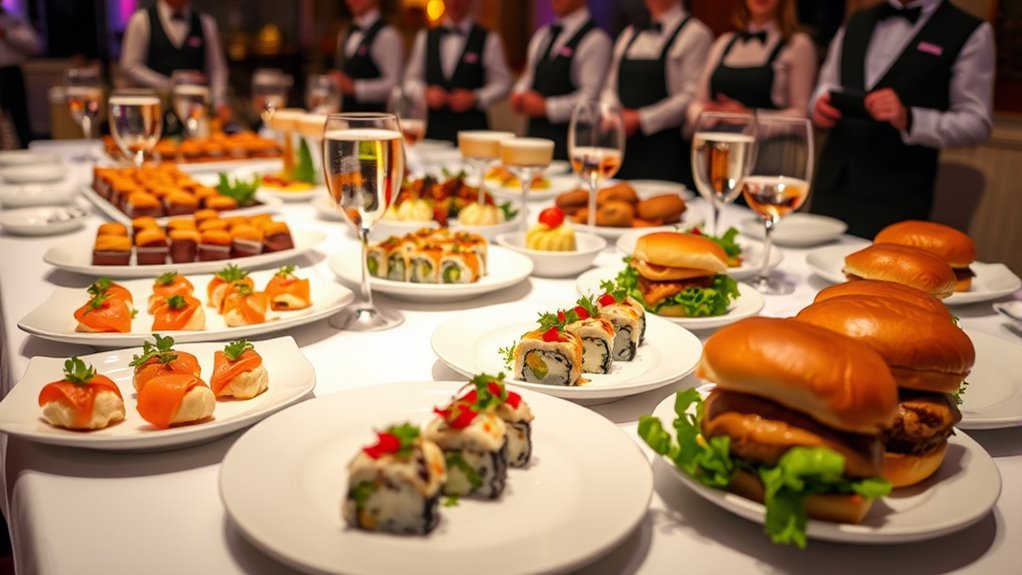To adapt your menu for different event audiences, you should consider cultural influences, dietary restrictions, and guest preferences. Incorporate diverse ingredients and familiar flavors from various cuisines to create an inclusive atmosphere. Clearly label allergen-free, vegetarian, and other options to show respect for guests’ needs. Offering a variety of choices, including vegan desserts or halal meats, helps guarantee everyone feels welcomed. Keep exploring strategies to make your menu truly versatile and guest-friendly.
Key Takeaways
- Understand the cultural backgrounds and preferences of your audience to select appropriate dishes.
- Incorporate diverse cuisines and flavors to reflect the guests’ cultural diversity and create an inclusive atmosphere.
- Collect dietary restrictions and preferences in advance to offer suitable allergen-free, vegetarian, vegan, or special diet options.
- Clearly label all dietary choices and culturally inspired dishes to aid guests in making informed selections.
- Provide a variety of options and thoughtful touches to ensure all guests feel welcomed, respected, and catered to.

When planning an event, tailoring your menu to suit the specific audience can make all the difference in creating a memorable experience. Understanding the diverse backgrounds and preferences of your attendees helps you craft a menu that resonates and feels inclusive. Cultural influences play a crucial role here; what’s considered a delicacy in one culture might be unfamiliar or unappealing to others. For example, offering dishes that incorporate ingredients or cooking styles from various cuisines shows respect and appreciation for your guests’ backgrounds. This approach not only enriches the dining experience but also encourages conversation and connection among attendees.
In addition, you need to be mindful of dietary restrictions that may affect your guests’ choices. Some people may have allergies to nuts, gluten sensitivities, or lactose intolerance, while others might follow specific diets for health, ethical, or religious reasons. Failing to accommodate these restrictions can lead to discomfort or even health risks for your guests, and it might leave a negative impression about your event planning. To address this, always ask for dietary information when inviting attendees or include a section in your RSVP for dietary needs. Then, plan your menu accordingly—offer gluten-free options, vegetarian or vegan dishes, or allergen-free alternatives. Clearly labeling these options helps guests make informed choices and demonstrates your attentiveness to their needs.
Balancing cultural influences with dietary restrictions might seem challenging, but it’s entirely doable with careful planning. For instance, if you’re serving a multicultural buffet, include labeled dishes that specify if they’re vegetarian, gluten-free, or contain common allergens. Incorporate familiar flavors from different cultures to make everyone feel at home, like offering a gluten-free Mexican corn salad, a vegan Thai stir-fry, or a dairy-free Mediterranean hummus platter. This way, you respect cultural diversity and dietary needs simultaneously, creating a welcoming environment for all attendees.
Furthermore, consider providing a variety of options rather than just one or two dishes. This ensures that everyone finds something suitable and shows your commitment to inclusivity. Remember, small touches like offering vegan desserts or halal meat options can markedly impact how your guests perceive your event. When you take the time to understand the cultural influences and dietary restrictions of your audience, you create an environment that feels thoughtful and considerate. Being aware of equipment needs and limitations can also help you better plan your menu setup and serving logistics, ensuring a smooth experience for everyone. Ultimately, this effort will enhance your guests’ experience, leaving them with positive memories and a strong impression of your attention to detail.
Frequently Asked Questions
How Do I Handle Dietary Restrictions at Large Events?
You handle dietary restrictions at large events by prioritizing menu customization to meet diverse needs. Collect dietary information in advance and clearly label options for dietary compliance, such as gluten-free or vegan. Work with your caterers to guarantee all special requests are accommodated safely. Communicate openly with guests about their restrictions, and offer a variety of suitable choices to make everyone feel included and respected.
What’s the Best Way to Gauge Audience Preferences?
You should start by actively engaging your audience through surveys and direct feedback to gauge their preferences. Pay close attention to their responses and observe their reactions during tastings or menu previews. This real-time insight helps you tailor your menu customization effectively, ensuring your offerings align with their tastes. By maintaining open communication and adapting based on audience engagement, you create an experience that resonates deeply, leaving a lasting impression.
How Can I Balance Cost and Variety in Menu Adaptation?
To balance cost and variety in menu adaptation, you should use strategic pricing and smart ingredient sourcing. Focus on affordable, versatile ingredients that can be used across multiple dishes to reduce waste and costs. Implement flexible pricing strategies, like tiered options or discounts, to meet different budgets. This approach helps you offer diverse choices without overspending, ensuring satisfaction for your audience while maintaining profitability.
Should I Include Local or Seasonal Ingredients?
You should include local and seasonal ingredients to enrich your menu, highlight freshness, and support community. Local sourcing offers vibrant flavors and reduces carbon footprint, while seasonal menus keep dishes exciting and aligned with what’s available. Embrace local and seasonal ingredients to create a dynamic, sustainable, and memorable dining experience that resonates with your guests and showcases your commitment to quality and responsibility.
How Do I Accommodate Cultural Food Preferences Effectively?
You can accommodate cultural food preferences effectively by incorporating cultural flavor into your menu and offering traditional dishes alongside your offerings. Research the specific cuisine, use authentic ingredients, and consider hiring consultants or consulting community members to guarantee accuracy. Show respect for traditions, and be flexible with modifications to meet dietary needs, making guests feel valued and comfortable. This approach demonstrates your commitment to inclusivity and enhances their overall experience.
Conclusion
By tailoring your menu to suit each event audience, you create an experience that’s both memorable and engaging. But what if the next event demands an unexpected twist? Will you be prepared to surprise and delight your guests in ways they never saw coming? The key lies in your ability to adapt seamlessly—because in this game, keeping your audience guessing might just be your secret ingredient for success. Are you ready to take that leap?








